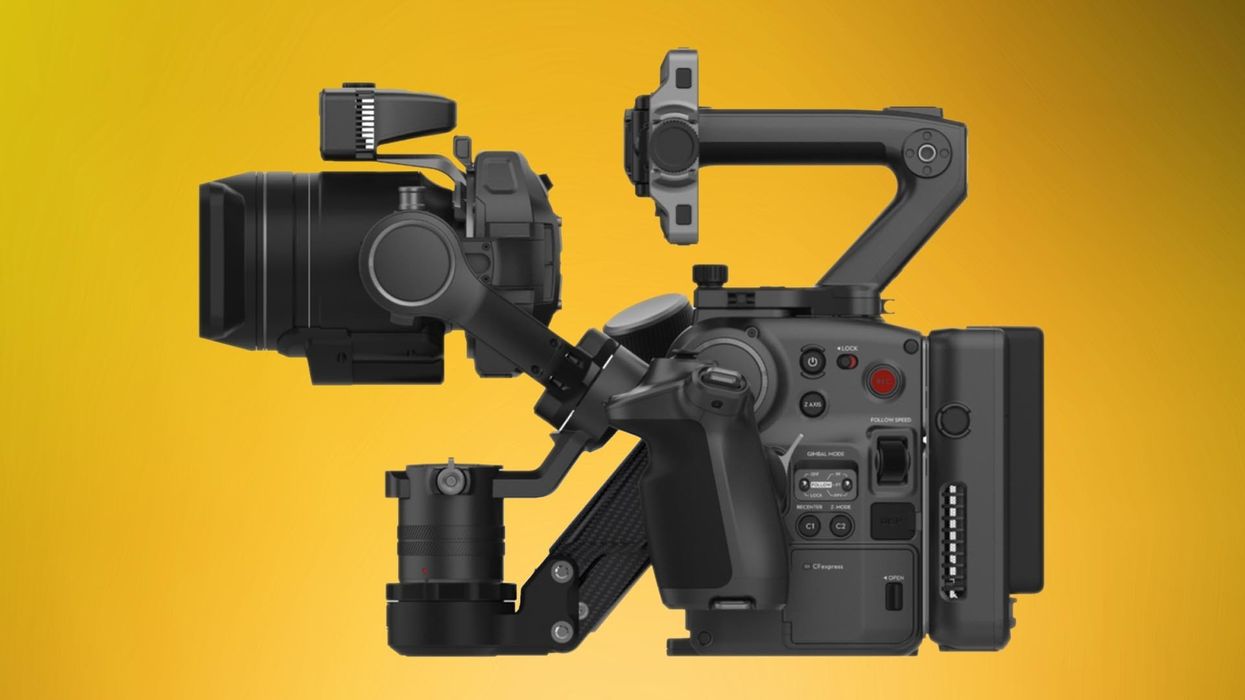With the Ronin 4D, DJI Answers the Question, "What If the Gimbal Were the Camera?"
DJI has announced its next flagship gimbal system, an all-in-one gimbal and camera setup called the Ronin 4D.

Boy, now that's an interesting-looking product. I think we can all agree that in terms of form factor and overall design, that is just... interesting.
I don't say that at all to knock the way it looks. In fact, I respect it, this just seems to defy class altogether. Much like when one looks at an eclipse for the first time, or when you see a rhino and a sheep become friends, it's not a bad thing. You've just never seen it before.
DJI has always pushed the boundaries of what affordable and solution-based filmmaking gear can do for you. They were the first ones to bring video drones into the mainstream, which has now become an entire industry all its own. They were the ones to bring us the first professional-level gimbals at a less than cost-prohibitive price (Ronin vs. Mōvi).
Then, they have the Osmo line, their all-in-one (or phone-based) gimbal/camera systems that have turned many hobbyists into vloggers and storytellers.
Now enters the Ronin 4D, which will combine DJI's all-new full-frame Zenmuse X9 gimbal camera, a 4-axis stabilization system, a LiDAR focusing system, and a video transmission system—all in one convenient (and interesting-looking) chassis. This product appears to merge all of the best and most solid aspects of what DJI has done before, while forging a new path with a type of form-factor and approach that we've never seen before with a cinema camera.
The Powerful Imaging System
The Ronin 4D includes a brand-new Zenmuse camera system (which you'll be familiar with if you're an Inspire 2 or Osmo user) called the X9, which will come in 8K and 6K flavors. Both versions are capable of recording Apple ProRes and ProRes RAW with up to 14 stops of dynamic range.
The X9-6K can go as high as 120fps, and the X9-8K can go up to 75fps. The imaging system also includes a dual-native EI of 800/5,000 which will be extremely usable in low-light scenarios.
The camera has built-in nine-stop physical ND filters. Yesssssss.
It has an interchangeable lens mount for the DJI proprietary DL mount, Leica M, and other mounts with short flange distances.
The First 4-Axis Stabilization System
The Ronin 4D is the first gimbal system with active z-axis motors to eliminate vertical camera shake. This makes it easier to shoot while walking or running. This also allows for more "slider-style" shots without the need for a dolly.
The gimbal system leverages all of the groundbreaking work DJI has done with its drone sensors and technology for use on the ground, with a set of downward, forward, and dual-visual sensors.
Even with the added axis and features, this whole system with camera included is still lighter than most full-blown cinema cameras attached to a gimbal system.
DJI's Activetrack (Pro) technology is present here as well, with some new bells and whistles that make use of AI to help you track objects and keep them in the right spot in your composition.
LiDAR Focusing System
I've been waiting for someone to start using LiDAR for autofocus. So glad it's here.
The Ronin 4D has a LiDAR range finder that is constantly generating precise distance measurements with over 43,200 ranging points. LiDAR is a beneficial technology for Autofocus, in my opinion, because it works the same in even the most low-light environments. It doesn't need to hunt for distance data, it's just there always.
They've also announced something called "Automated Manual Focus," which basically allows you to use autofocus but intervene with the system when necessary, moving the focus wheel yourself.
I'll be intrigued to see how intuitive and tactile that feature feels.
Video Transmission System
The Ronin 4D has a built-in video transmitter.
Capable of outputting a full HD signal (up to 60fps) to a range of up to nearly 20,000 feet, the built-in transmitter appears to leverage even more of DJI's knowledge from other lines, like their superb distance with drone live-feeds and such. Very smart call to include a built-in transmitter into the system, a feature I'm sure we'll start to see more and more in camera releases in years to come.
They also have an additional "High-Bright" remote monitor available that includes a gyroscope (allowing monitor motion control) and can connect to almost all of their other "wireless" related gear like the DJI Master Wheels, DJI Force Pro, or their three-channel follow-focus unit.
The whole thing seems like an interesting modular system that can do just about anything you'd need a camera to do. I for one will be pixel peeping the footage extremely hard to see if this thing is living up to the spec sheet.
Regardless, I have to commend DJI for going out on this limb and really doing something different.
The price for the DJI Ronin 4D bundle will be $7,199 for the 6K version and $11,499 for the 8K.











